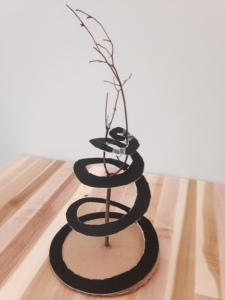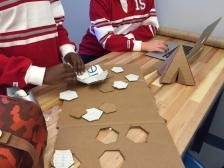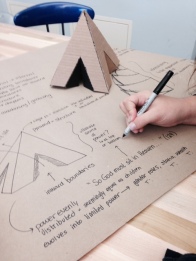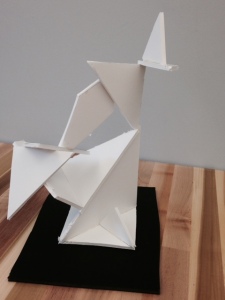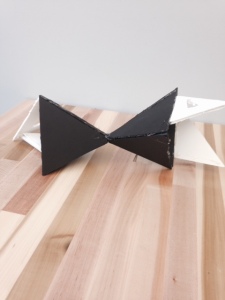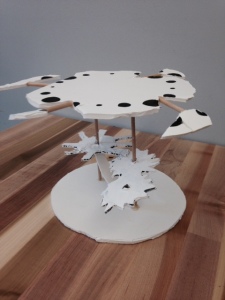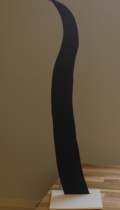Using the Makerspace to Re-imagine Literary Texts
The humanist Michel de Montaigne in 1580 conceived of the essay as an attempt to display discernment and thinking, a kind of theater of mind. More than 400 years later, students in literature classes still write essays incessantly: lower school essays, middle school essays, high school essays, college essays, application essays.
Essays. Essays. Essays.
As a long-term teacher of 10th and 12th grade English and world literature, I am always seeking innovative ways to inspire students to think abstractly about a literary text. Reading any text requires entry into the world presented by the writer; a text is a literary space that inspires multiple and layered interpretations. I am interested in encouraging students to examine texts as symbolic structures and systems that they enter and inhabit — meandering, sauntering and stopping, then exiting, and possibly returning again and again.
Following Mark Twain’s suggestion that students shouldn’t “let school get in the way of their education,” I invited AP English and World Literature Honors students to disrupt the cycle.
“Let’s hack the essay,” I suggested.
Influenced by the work of Matteo Pericoli at Columbia University’s Laboratory of Literary Architecture (http://www.lablitarch.com), and a project by an unknown but inspiring colleague’s work with 10th graders on Catcher in the Rye, my teaching and learning goals for the upcoming year involve conceptualizing ways for students to use the new Makerspace at our school to imagine literary texts as spaces in which readers immerse themselves.
During the past few weeks, talented literature students have been engaged in applying critical and creative thinking skills to their understanding of a complex, ambiguous work, Pulitzer prize winning author Annie Dillard‘s memoir, An American Childhood . After reading, annotating, and analyzing this text in Harkness discussions at the seminar table, classes entered the Makerspace.
Project: Constructing An American Childhood
I woke in bits, like all children, piecemeal over the years. I discovered myself and the world, and forgot them, and discovered them again. I noticed this process of waking, and predicted with terrifying logic that one of these years not are away I would be awake continuously and never slip back, and never be free of myself again. Dillard
Goal: To spatialize Annie Dillard’s An American Childhood; to model your understanding of the memoir through dimensional thinking. Focusing on Dillard’s key word in the opening paragraph of the memoir (“topology“), and her use of nature imagery throughout, aim to distill the narrative into driving themes, and then come up with an abstract shape.
Final Product: a 3-D shape that captures your interpretation of the essence of the text.
Written piece: An artist’s statement that explains your choices. 2 pages.
In the first Makerspace class, students condensed the text into its driving themes by brainstorming and sketching ideas and images that reflected their interpretations of the key elements of the text. They used a scroll of brown kraft paper and sharpies. They began to map out and spatialize their ideas, adding relevant graphic and visual elements.
The next step: applying the maker model of designing, tinkering, prototyping, and fabricating through creative, visual, artistic, systematic analysis and interpretation — in ways other than writing an essay.
What might the un-essay look like? Have a look at these creative interpretations.
I hope to inspire colleagues to use the maker model of tinkering, prototyping, and iteration in their high school literature and humanities classes. I am interested in the convergence of STEM and Design Thinking approaches to problem solving as applied to literary production and analysis: digital humanities, data visualization, info-graphics, i.e. alternative ways of interpreting the layers of meaning and structural architectonics of literary texts.
This was an interesting way to assess students’ capacity for abstract thinking and problem-solving. Of course, we began our studies of this layered text with close reading and analysis — and several short essays. The process of literary discovery ended with a single abstract shape.
This student’s design is a clock. The two clock faces are white to reflect the “times when Dillard is awake.” The gears are black to reflect moments of unawareness. In the Artist Statement, this student eloquently wrote: “Ultimately, I think I learned a new way to envision texts. By going through my own process of constructing my own symbolism of Dillard’s awareness of time, I think that I also gained a new way to conceptualize the idea of time. On a plane coming back to New York from St. Louis I was finishing up the last two chapters of An American Childhood. As we flew over the city at night, and everything was lit up against the dark skyline, I remembered thinking and jotting down in the back of my book, ‘never forget the wonder of looking out the window of an airplane.’ It was in this moment that I realized that I had awakened through reading this book. More specifically, awakened to the passage of time. I think that previously I had been aware of other aspects of life, but never really to the limit of time or the opportunity to take advantage of it….I saw time flying by, and people’s lives going on without me even knowing them and just had an incredible sense of awe and wonder beyond my comprehension. Now, like Dillard, I am poised to ‘break through the skin of awareness a thousand times a day, as dolphins burst through seas, and dive again, and rise, and dive.’ (250)
Through conceptualizing imaginative ways to hack high school literature and humanities classes and assessments, I aspire to untether students and teachers from the iterative, way-too-predictable process of reading, sitting, discussing, sitting some more, and writing an essay.
